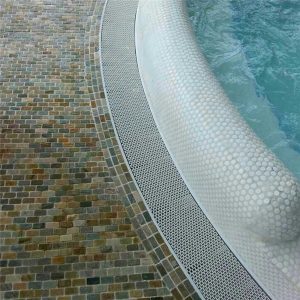Introduction (200 words)
Travertine has long been admired for its natural beauty and versatility in architectural and design applications. Its unique appearance, characterized by intricate patterns and earthy tones, has made it a popular choice for various projects, from classic buildings to contemporary homes. However, the extraction and processing of natural travertine can be resource-intensive and environmentally damaging. In recent years, an innovative solution has emerged in the form of cultured travertine. This article will explore the concept of cultured travertine, its production process, advantages, and its potential impact on the future of architectural and design industries.
1. Understanding Cultured Travertine (400 words)
Cultured travertine, also known as engineered or faux travertine, is a manufactured alternative to natural travertine. It is created by combining natural travertine dust or chips with a binding material, such as resin or cement, to form slabs or tiles that mimic the appearance of genuine travertine. The manufacturing process allows for precise control over the color, texture, and pattern, resulting in consistent and customizable options for designers and architects.
2. The Production Process (500 words)
The production of cultured travertine involves several stages to ensure quality and durability. First, the travertine dust or chips are collected from quarries, ensuring minimum waste and utilization of resources. The collected material is then mixed with the chosen binding agent in specific ratios, depending on the desired characteristics of the final product.

Once the mixture is prepared, it is poured into molds or forms, which can be customized to create various sizes and shapes of tiles or slabs. The mixture is then left to cure and harden under controlled conditions, allowing it to solidify into a stable and durable material.
After the initial curing process, the cultured travertine undergoes additional treatments to enhance its appearance and performance. These treatments may include polishing, honing, or sealing, depending on the desired finish. The final product is then inspected for quality assurance before being packaged and shipped to customers.
3. Advantages of Cultured Travertine (600 words)
Cultured travertine offers several advantages over natural travertine, making it an appealing choice for architects, designers, and homeowners alike. Some key advantages include:
3.1 Cost-effectiveness: One of the most significant advantages of cultured travertine is its affordability compared to natural travertine. The production process allows for greater control over costs, making it a cost-effective alternative without compromising on the visual appeal.
3.2 Consistency and Customization: Cultured travertine provides consistent patterns, textures, and colors, eliminating the natural variations and inconsistencies found in natural stone. This consistency allows for easier planning and execution of design projects. Additionally, cultured travertine can be customized to meet specific design requirements, offering a wide range of options to suit various aesthetics.
3.3 Durability: Cultured travertine is engineered to be highly durable and resistant to wear, making it suitable for high-traffic areas, such as commercial spaces or outdoor applications. The binding agents used in its production provide stability and strength, ensuring the longevity of the material.
3.4 Sustainability: Cultured travertine minimizes the environmental impact associated with natural stone extraction. By utilizing travertine waste or chips and reducing the need for quarrying, cultured travertine helps preserve natural resources and reduces carbon emissions. Additionally, the manufacturing process can be optimized to reduce water consumption and waste generation.
3.5 Ease of Installation and Maintenance: Cultured travertine is typically lighter in weight than natural stone, making it easier to handle and install. Its consistent thickness and size also simplify the installation process. Furthermore, it requires minimal maintenance, with sealing or periodic cleaning being sufficient to keep it in excellent condition.
4. Potential Impact on the Future (400 words)
The rise of cultured travertine represents a significant shift in the architectural and design industries. As sustainability and resource conservation become increasingly important, the use of cultured travertine offers a viable solution to satisfy the demand for natural stone aesthetics while minimizing environmental impact.
The versatility and customizability of cultured travertine open up new possibilities for designers and architects, enabling them to create unique spaces without the limitations imposed by natural stone variations. Roofing Slate For Sale , combined with its cost-effectiveness, may lead to a wider adoption of cultured travertine in both residential and commercial projects.
In terms of environmental impact, the reduced reliance on natural stone extraction can contribute to a more sustainable future. By utilizing travertine waste or chips that would otherwise go to waste, cultured travertine reduces the need for additional quarrying, effectively conserving natural resources and minimizing carbon emissions associated with transportation and processing.
Furthermore, the manufacturing process for cultured travertine can be refined to reduce water consumption, energy usage, and waste generation, making it an even greener alternative. As sustainability becomes a top priority, the development and adoption of eco-friendly manufacturing practices will further enhance the appeal of cultured travertine.
Conclusion (200 words)
Cultured travertine offers a modern and sustainable solution for those seeking the timeless elegance of natural travertine without the associated drawbacks. Its production process not only reduces environmental impact but also provides consistent patterns and customizable options for designers and architects. The cost-effectiveness, durability, and ease of maintenance further contribute to its appeal, making it a versatile choice for various applications.
As the architectural and design industries continue to evolve, the utilization of cultured travertine may become more prevalent, driven by the need for sustainable materials and the desire for aesthetic excellence. With ongoing advancements in manufacturing technology and increased awareness of environmental concerns, cultured travertine is poised to be a significant player in the future of architectural design, providing a perfect balance between elegance and sustainability.
